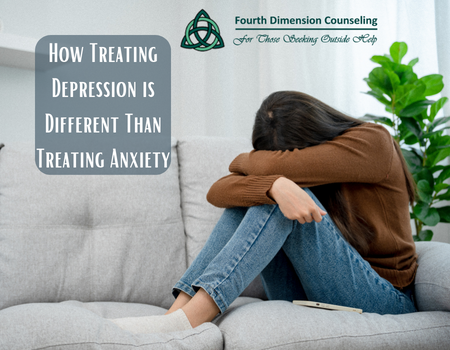Treating depression is surprisingly different than treating anxiety for a few reasons. Depression and anxiety are two prevalent mental health conditions that affect millions of individuals worldwide. While they share some common features, the nuances in their symptoms and underlying mechanisms necessitate different approaches to treatment.
Treating Depression and Anxiety
 Before delving into the treatment approaches, it is essential to grasp the fundamental differences between depression and anxiety.
Before delving into the treatment approaches, it is essential to grasp the fundamental differences between depression and anxiety.
Depression:
Depression, also known as clinical depression or major depressive disorder (MDD), and symptoms include deep-seated feelings of hopelessness, sadness, and a lack of interest in once interesting and enjoyable activities. Individuals with depression often experience changes in sleep patterns, appetite, and energy levels. Negative thoughts about oneself, the world, and the future are pervasive, contributing to a sense of worthlessness and guilt.
Anxiety:
Anxiety, on the other hand, encompasses a range of disorders characterized by excessive worry, fear, and heightened physiological arousal. It often involves a preoccupation with potential future threats, leading to persistent and uncontrollable worry. Physical symptoms, such as increased heart rate, muscle tension, and restlessness, are common in anxiety disorders.
Differentiating Treatment Approaches
While depression and anxiety may coexist or share overlapping symptoms, treating them involves distinct therapeutic approaches. Mental health professionals carefully assess the predominant symptoms and tailor interventions to address the unique challenges posed by each condition.
- Psychotherapy (Counseling):
- Treating Depression: Cognitive-behavioral therapy (CBT), interpersonal therapy (IPT), and psychodynamic therapy are commonly employed to address negative thought patterns, explore underlying emotions, and promote positive behavioral changes. Therapists work with individuals to identify and challenge distorted thinking, helping them develop healthier coping mechanisms.
- Treating Anxiety: Cognitive-behavioral therapy is also a primary intervention for anxiety disorders. CBT helps individuals identify and modify irrational thought patterns, manage excessive worry, and gradually confront feared situations through exposure therapy. Mindfulness-based therapies are often incorporated to promote relaxation and reduce the physiological symptoms associated with anxiety.
- Medication:
- Treating Depression: Antidepressant medications, such as selective serotonin reuptake inhibitors (SSRIs) or serotonin-norepinephrine reuptake inhibitors (SNRIs), are frequently prescribed to alleviate depressive symptoms. These medications work by affecting neurotransmitter levels in the brain, helping to lift mood and improve overall functioning.
- Treating Anxiety: Similar to depression, antidepressants are commonly used to manage anxiety disorders. Additionally, benzodiazepines may be prescribed for short-term relief of acute anxiety symptoms. These medications act on the central nervous system to induce calming effects, but they are generally prescribed cautiously due to the risk of dependence.
- Lifestyle Changes:
- Treating Depression: Regular exercise, a balanced diet, and sufficient sleep are integral components of managing depression. These lifestyle changes contribute to overall well-being, help regulate mood, and complement therapeutic interventions.
- Treating Anxiety: Stress management techniques, relaxation exercises, and mindfulness practices play a crucial role in alleviating anxiety symptoms. Establishing a routine that includes regular physical activity and adequate sleep can contribute to a calmer and more balanced state of mind.
- Support Groups:
- Treating Depression: Participating in support groups provides individuals with a platform to share their experiences, receive understanding, and connect with others facing similar challenges.
- Treating Anxiety: Support groups for anxiety disorders offer a space where individuals can share coping strategies, discuss common triggers, and receive encouragement from those who understand the complexities of living with anxiety. Peer support is particularly valuable in normalizing experiences.
- Focus of Therapy:
- Treating Depression: Therapeutic interventions for depression often involve addressing core beliefs, self-esteem, and exploring the impact of past experiences on the present. The focus is on restructuring negative thought patterns and fostering a more positive self-image.
- Treating Anxiety: In anxiety-focused therapy, the emphasis is on managing excessive worry, challenging irrational fears, and developing effective coping strategies. Therapists work with individuals to confront feared situations gradually, helping to desensitize them to anxiety triggers.
- Behavioral Activation:
- Treating Depression: Behavioral activation is a therapeutic approach that encourages individuals to engage in positive and rewarding activities, even when motivation is low. By reintroducing pleasurable activities, individuals with depression can gradually rebuild a sense of joy and accomplishment.
- Treating Anxiety: Behavioral activation for anxiety involves exposure to feared situations in a controlled and gradual manner. This helps individuals confront and overcome anxiety-provoking scenarios, reducing avoidance behaviors.
- Cognitive Restructuring:
- Treating Depression: Cognitive restructuring in depression therapy involves challenging and changing negative thought patterns. This process aims to alter distorted beliefs about oneself, others, and the future, promoting a more realistic and positive outlook.
- Treating Anxiety: In anxiety-focused cognitive restructuring, individuals work to identify and challenge catastrophic thinking patterns. This helps reduce excessive worry and allows for a more balanced assessment of potential threats.
Challenges in Co-Occurrence
It’s not uncommon for individuals to experience both depression and anxiety simultaneously, a condition referred to as comorbid depression and anxiety. Managing these co-occurring conditions requires a nuanced approach, considering the interplay of symptoms and tailoring interventions to address both sets of challenges.
In cases of comorbidity, mental health professionals often prioritize the treatment of the condition that is more severe or impairing daily functioning. As symptoms improve, a more integrated approach may be adopted to address the complexities of both depression and anxiety.
Conclusion
Treating depression and anxiety involves a multifaceted and individualized approach, considering the unique characteristics of each condition. From psychotherapy and medication to lifestyle changes and support groups, mental health professionals employ a diverse range of strategies to help individuals navigate their mental health challenges.
Understanding that depression and anxiety are complex and dynamic conditions underscores the importance of seeking professional help. Mental health care is not a one-size-fits-all endeavor, and effective treatment requires a collaborative effort between individuals and their mental health care providers.
